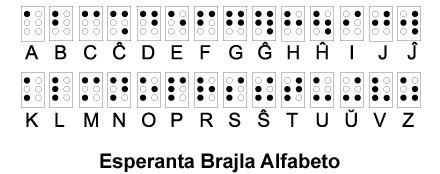Type alphabet | ||
 | ||
Parent systems BrailleEsperanto Braille | ||
Esperanto Braille is the braille alphabet of the Esperanto language. One Esperanto Braille magazine, Aŭroro, has been published since 1920, and another, Esperanta Ligilo, since 1904.
Contents
Alphabet
The basic braille alphabet is extended for the print letters with diacritics. The circumflex is marked by adding dot 6 (lower right) to the base letter: ⠩ ĉ, ⠻ ĝ, ⠳ ĥ, ⠺ ĵ, ⠮ ŝ. Therefore, the letter ĵ has the same form as the unused French/English Braille letter ⠺ w; to write a w in a foreign name, dot 3 is added: ⠾ w (see next section). Esperanto ŭ is made by reflecting u, so that dot 1 becomes dot 4: ⠬ ŭ. The alphabet is thus as follows.
Contracted braille is in limited use.
Transcribing foreign letters
Beside the basic-Latin foreign letters q, w, x, y, there are dedicated letters for the umlauted vowels that occur in print German, ä, ö, ü:
Additional accented letters in other languages are handled by separate braille cells for the diacritics. These do not have a one-to-one correspondence with print:
These conventions are used for foreign names adapted to Esperanto Braille. Unassimilated text in another braille alphabet is indicated by the code ⠐⠂.
Punctuation
The apostrophe and abbreviation point are both transcribed ⠄, which is distinct from the period/stop, ⠲.
Quotation marks in print Esperanto are highly variable, and tend to follow the conventions of the country a text is published in. This is irrelevant for printing in braille.
Numbers
The apostrophe/abbreviation point ⠄ is used to group digits within numbers, like the comma in English. In both print and braille Esperanto, the comma is used as the decimal mark, so:
print English 100,000.00= print Esperanto 100 000,00= braille ⠼⠁⠚⠚⠄⠚⠚⠚⠂⠚⠚.Formatting
Capitals are only marked for proper names and at the beginning of a sentence.
For emphasis (bold or italics in print), a simple ⠸ is used to mark each of one to three words. For longer emphatic text, there are two formats: Either a colon precedes the simple emphatic sign, ⠒⠸, and an additional sign ⠸ is placed before the last emphasized word, or the sign ⠠⠄ is placed before and after the emphasized text.
In contracted (grade 2) braille, a different sign is used for capital letters, ⠠ (dot 6). As in most braille orthographies, proper names are not contracted, and words preceded by this sign are not contracted in Esperanto Braille.
